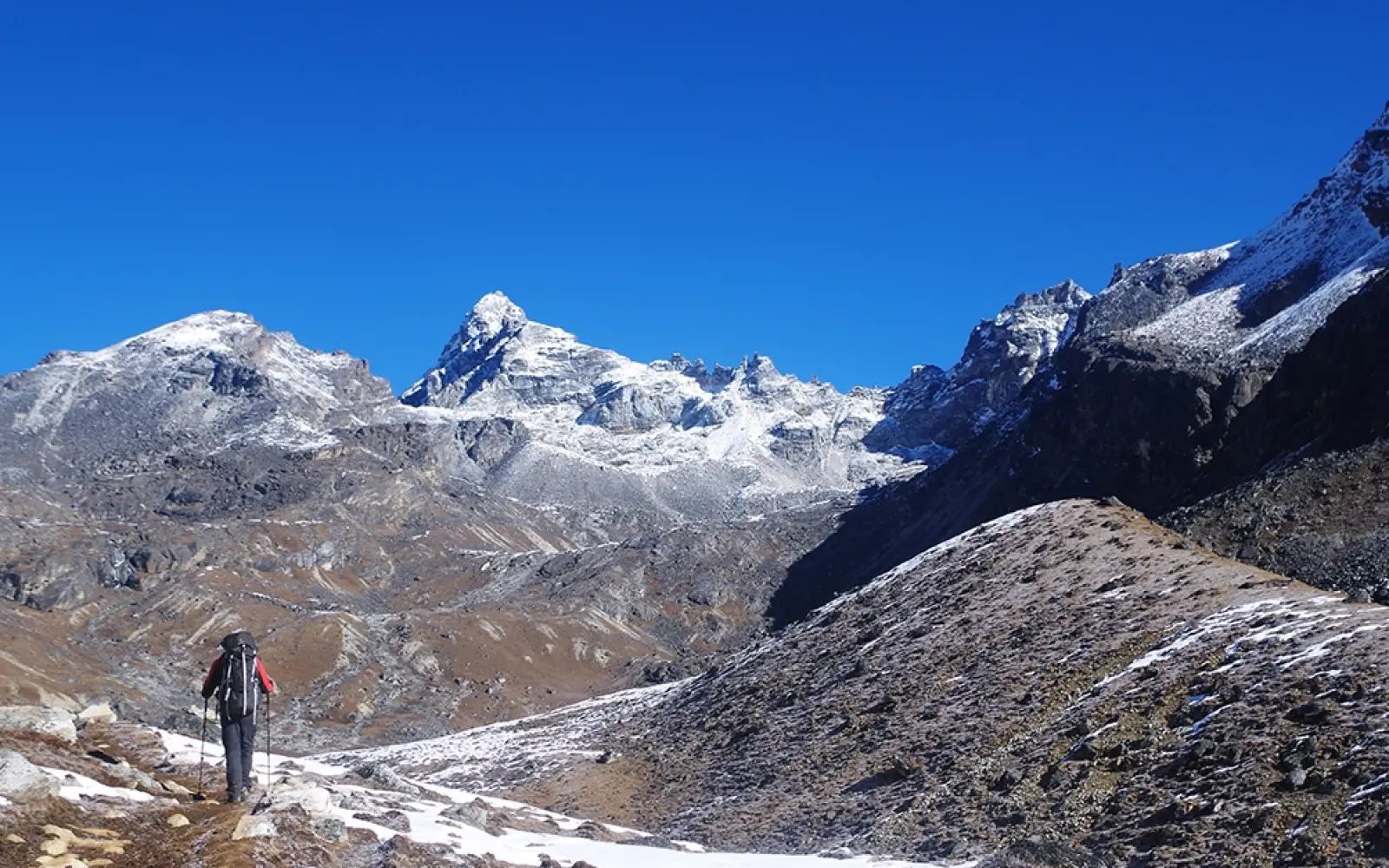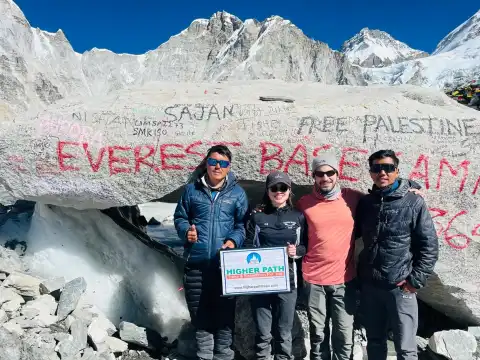Must-Know Facts About Everest Base Camp Trekking
Trekking to Everest Base Camp (EBC) is one of the most iconic adventures in the world, offering a blend of natural grandeur, rich cultural experiences...

Trekking to Everest Base Camp (EBC) is a dream for adventurers worldwide, and many wonder if it’s possible to do it solo. Solo trekking to EBC is indeed possible, though it comes with unique challenges and responsibilities. Unlike guided treks, solo trekking requires self-reliance, careful planning, and a deep understanding of the route, weather, and altitude conditions. Solo trekkers can enjoy a sense of freedom, personal achievement, and an intimate connection with the Himalayan environment, but safety remains a key consideration.
Many trekking agencies, including Higher Path Treks & Expeditions, offer guidance and support for solo trekkers, from pre-trip planning to logistical arrangements such as permits, flights, and local accommodations. Trekking solo does not mean complete isolation; even on independent treks, lodges and teahouses along the route provide opportunities to meet fellow trekkers and locals. For those who prefer solitude and personal pacing, solo trekking allows full control over daily itineraries, acclimatization schedules, and photographic stops.
Key points:
Everest Base Camp is one of the most iconic trekking destinations globally, attracting thousands every year. While group treks are common, solo trekking has grown in popularity as more adventurers seek personal challenges. Solo trekking to EBC demands independence, decision-making skills, and the ability to manage unpredictable conditions such as sudden weather changes, altitude sickness, or trail diversions.
The journey begins typically in Kathmandu, moving through Lukla, Namche Bazaar, and onward through high-altitude villages like Dingboche and Gorak Shep. Solo trekkers experience the trek at their own pace, often forming temporary bonds with other trekkers along the way. Higher Path Treks & Expeditions emphasizes safety, offering route briefings, emergency contacts, and pre-arranged accommodations for solo travelers. With modern technology like GPS, mobile connectivity in certain regions, and robust teahouse networks, solo trekking is more accessible than ever.
Key points:
Solo trekking offers a distinct appeal: complete freedom, introspection, and the opportunity to set a personal pace. Trekkers can choose their stops, take extended breaks for photography or acclimatization, and enjoy uninterrupted time in nature. For many, trekking solo is as much about mental exploration as physical endurance. It cultivates self-reliance, decision-making skills, and confidence in handling unexpected situations.
However, the challenges cannot be overlooked. Solo trekkers must navigate high-altitude terrain without the immediate support of a group. Weather conditions can change rapidly, and altitude sickness can be dangerous if not addressed promptly. Social isolation may also be a factor, though interactions with fellow trekkers or locals can mitigate this. Planning is critical: arranging permits, flights, accommodations, and emergency strategies are all responsibilities of the solo trekker. Agencies like Higher Path Treks & Expeditions help balance independence with safety, providing guidance without compromising the solo experience.
Key points:
Physical fitness is crucial for solo trekking to EBC. The trek involves multiple days of uphill and downhill walking, often above 3,000 meters, so cardiovascular endurance, leg strength, and flexibility are key. Regular training, including long hikes with a loaded backpack, stair climbing, and aerobic exercises, prepares the body for altitude and physical strain. Mental preparation is equally important, as solo trekking demands resilience in facing unexpected obstacles.
Gear selection can make or break the trek. Essentials include sturdy trekking boots, layered clothing suitable for cold and unpredictable weather, a sleeping bag, trekking poles, a first aid kit, and portable oxygen in extreme cases. Carrying a detailed map, GPS device, or smartphone with trekking apps ensures navigation safety. Planning involves arranging flights to Lukla, obtaining TIMS and Sagarmatha National Park permits, booking teahouses in advance, and knowing emergency evacuation options. Higher Path Treks & Expeditions provides tailored support for solo trekkers, including gear advice, acclimatization tips, and detailed itineraries for a safe and enjoyable journey.
Key points:
Choosing the right trekking route is crucial for a successful solo Everest Base Camp (EBC) experience. The standard route from Lukla to EBC is the most popular, well-established, and serviced with numerous teahouses, lodges, and trekking facilities. It passes through iconic locations such as Namche Bazaar, Tengboche Monastery, Dingboche, and Gorak Shep, offering breathtaking views of Everest, Lhotse, and Ama Dablam. For first-time solo trekkers, this route is recommended due to its relative safety, clear signage, and reliable support infrastructure.
Alternative routes, like the Gokyo Lakes trek or routes via the Renjo La pass, provide more solitude and unique perspectives of the Everest region. These paths are less crowded but more challenging, with fewer lodges and higher exposure to unpredictable weather and altitude-related risks. Solo trekkers considering alternative paths need advanced planning, strong navigation skills, and contingency plans. Agencies like Higher Path Treks & Expeditions can help design a tailored itinerary, ensuring that both standard and alternative routes are feasible while considering fitness level, acclimatization needs, and personal goals.
Key points:
Safety is the top priority for solo trekking to EBC. Altitude sickness is a major concern, as trekkers rapidly ascend above 3,000 meters. Symptoms include headaches, nausea, dizziness, and fatigue, which can escalate to life-threatening conditions if ignored. Proper acclimatization, hydration, and gradual ascent are essential. Solo trekkers should carry a first aid kit, know emergency evacuation procedures, and be able to recognize warning signs of severe altitude sickness.
Weather in the Himalayas can change abruptly, with snowstorms, high winds, and sub-zero temperatures at higher elevations. Solo trekkers must prepare for sudden changes in conditions and pack layered clothing, thermal gear, and reliable navigation equipment. Agencies like Higher Path Treks & Expeditions provide detailed safety briefings, 24/7 emergency contacts, and guidance on weather monitoring, which is invaluable for solo travelers navigating these extreme environments. Awareness, preparation, and cautious decision-making are critical to staying safe during the trek.
Key points:
Trekking to EBC requires several permits to comply with Nepalese regulations. The key documents include the TIMS (Trekkers’ Information Management System) card and the Sagarmatha National Park entry permit. TIMS ensures that authorities can track trekkers and provides basic safety information. The Sagarmatha National Park permit allows access to the protected region surrounding Everest, helping preserve its unique environment and wildlife. Solo trekkers must carry valid identification and keep these permits accessible at all times.
Permits are strictly enforced at entry points and along trekking routes. Failure to obtain them can result in fines or denial of access. Working with a trusted agency like Higher Path Treks & Expeditions ensures all permits are obtained in advance, reducing stress and allowing trekkers to focus on their journey. Agencies also provide guidance on park regulations, waste management, and cultural sensitivity, helping trekkers respect the local communities and environment. Proper preparation is vital for a smooth and legal trekking experience.
Key points:
Accommodation on the Everest Base Camp trek primarily consists of tea houses—simple lodges offering beds, basic meals, and warm communal spaces. These lodges are widely available along the standard route, with increasing scarcity at higher altitudes. Meals are typically Nepali-style, including dal bhat (lentils and rice), noodles, soups, and limited Western options. Water is available but often requires purification tablets or boiling, and solo trekkers should carry reusable bottles to reduce plastic waste.
Camping is an alternative for those seeking more privacy or trekking alternative routes where tea houses are limited. Solo trekkers must carry tents, cooking equipment, and supplies, increasing the physical demands of the trek. Agencies like Higher Path Treks & Expeditions can pre-arrange accommodations, suggest suitable lodges, and provide advice on high-quality food options to maintain energy and health during the trek. Even solo travelers can enjoy comfort and safety by planning accommodations strategically.
Key points:
Navigating the Everest Base Camp (EBC) trek alone requires preparation, focus, and constant attention to the trail. While the standard route from Lukla to EBC is well-marked, there are sections where paths diverge, and trail markers can be unclear, particularly after landslides or snowfall. Solo trekkers should carry a detailed map, GPS-enabled devices, and trekking apps for real-time tracking. A compass and basic map-reading skills are highly recommended as backup navigation tools in areas with limited connectivity.
Following trail signs, mile markers, and consulting local guides when uncertain are crucial for staying safe. Solo trekkers should also pay attention to natural landmarks, altitude checkpoints, and teahouse locations for orientation. Agencies like Higher Path Treks & Expeditions offer pre-trek briefings, route maps, and emergency communication plans to ensure trekkers stay on course. Keeping a daily itinerary and informing lodge owners or staff about your planned progress can further reduce risks. Solo trekking emphasizes self-reliance, but using available resources and planning smart navigation strategies make the journey safer and more enjoyable.
Key points:
Solo trekking to EBC is often described as a journey of self-discovery. Many trekkers report feeling a deep connection with the mountains, the culture, and themselves. Walking alone allows one to move at a personal pace, pause for photography, journaling, or simply absorbing the breathtaking Himalayan scenery. Encounters with fellow trekkers or friendly locals in teahouses often create fleeting but meaningful connections that enrich the journey.
Challenges, however, are part of the experience. Solo trekkers face unpredictable weather, altitude adjustments, and logistical concerns on their own. Overcoming these obstacles builds resilience, confidence, and problem-solving skills. Stories from the trail often highlight moments of triumph, such as reaching Namche Bazaar after a challenging ascent, witnessing sunrise over Ama Dablam, or standing at Everest Base Camp itself. Agencies like Higher Path Treks & Expeditions help solo travelers plan itineraries, acclimatization schedules, and safety measures, allowing trekkers to focus on the transformative experience rather than logistics. Solo trekking can be demanding, but it is equally rewarding, creating memories and personal growth that last a lifetime.
Key points:
Solo trekking to Everest Base Camp is an adventure that blends personal challenge, freedom, and cultural immersion. It is suitable for those who are physically prepared, mentally resilient, and capable of independent decision-making. Trekkers must consider altitude risks, unpredictable weather, and logistical demands when evaluating whether to embark alone. With careful planning, adequate preparation, and the right support, solo trekking can be a transformative and fulfilling experience.
Working with a reputable agency like Higher Path Treks & Expeditions allows solo trekkers to enjoy independence while maintaining safety. They provide route planning, permit assistance, emergency support, and advice on accommodation and food, minimizing risks without compromising the solo experience. For many, the journey to Everest Base Camp alone is not just a trek but a personal journey of growth, reflection, and achievement. If you are ready to embrace both the challenges and rewards, solo trekking to EBC may be the perfect adventure to test your limits and create unforgettable memories.
Key points:

Trekking to Everest Base Camp (EBC) is one of the most iconic adventures in the world, offering a blend of natural grandeur, rich cultural experiences...

Trekking to Everest Base Camp (EBC) and the summit of Kala Patthar is a dream for many adventurers, and I was fortunate to turn that dream into a real...

Exploring on the Everest Base Camp (EBC) trek is more than just a journey through the Himalayas—it's a spiritual, cultural, and personal adventure tha...
